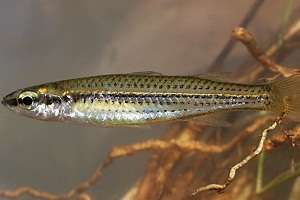Estimates of conservation risk for Kimberley freshwater fish may be too low

A Melbourne-based PhD student is assessing the conservation risk for freshwater fish in the Kimberley in the belief many are in danger of extinction but are not listed as threatened.
University of Melbourne PhD student Matthew Le Feuvre says 50 of Australia's 250-odd freshwater fish species live in the Kimberley and about 18 are only found in the region.
He says about 20 per cent of the country's freshwater fish are listed as threatened by the Commonwealth Government but none of those are from the Kimberley.
Mr Le Feuvre has spent six months in the Kimberley studying freshwater fish in the last year and a half, focusing on the northern and eastern parts of the region and predominantly between the Ord and Prince Regent rivers.
The project has mainly surveyed rivers with road access but the research team has also used a helicopter to fly into more remote areas.
Some of the rivers have only been surveyed once, in the 1970s.
Mr Le Feuvre says "very, very little" is known about freshwater fish species endemic to the Kimberley.
He points to the Mitchell gudgeon, a fish found only within 10km of river either side of the Mitchell Falls, as an example of a species at risk.
"If there was development in that region or rainfall levels changed with climate change and those sorts of processes it might mean that species could get wiped out very easily," Mr Le Feuvre says.
"Then there are other species that are found in single river systems such as the long-nose sooty grunter, which appears to be an entirely piscivorous fish, so it just eats other fish."
Mr Le Feuvre says the Kimberley is an incredibly biodiverse part of Australia and we have a "unique opportunity" to study it before any major development happens.
As well as collecting data about the distribution and abundance of freshwater species, Mr Le Feuvre is studying the fishes' diet, life history traits such as growth rate, age of reproduction and longevity and their ability to respond to climate change.
He is using a "triple jeopardy" hypothesis to determine the risk of extinction.
This means a species is considered to be at the greatest risk if it is range-restricted, is not very abundant where it is found and has specialised dietary, habitat, physiology or reproductive requirements.
"With those three factors against them they may be at incredibly high risk of extinction," Mr Le Feuvre says.
"It makes intuitive sense but very few people have managed to actually empirically test that."
Provided by Science Network WA



















